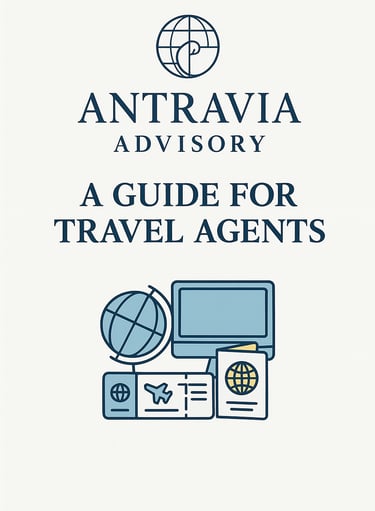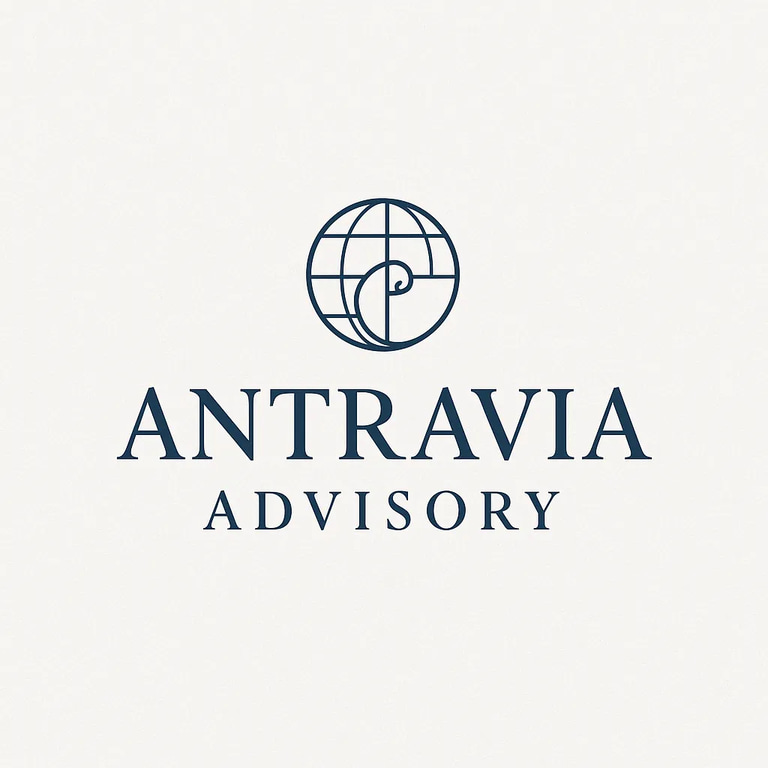
Travel Agent Finance Guide 2025: 5.2 Cruises, river cruises, and niche travel models
Part 5.2 of the Antravia Travel Agent Finance Guide - Explore how cruises and niche travel products shape your agency’s finances. Learn why high commissions come with long booking cycles, how to manage deferred income and revenue recognition, and how to balance your product mix for stronger cash flow and profit stability.
ANTRAVIA TRAVEL AGENT GUIDE
1/19/20257 min read


Part 5: Destinations and Market Positioning
In this part of our Travel Agent Finance Guide, we connect financial performance with the destinations you choose to sell. The mix of markets an advisor focuses on, whether luxury Europe, adventure Africa, emerging Asia, or ocean and river cruises, has direct implications for commission levels, supplier payment terms, and foreign exchange exposure.
Each market also comes with its own financial mechanics: currencies, settlement cycles, and credit practices that determine how quickly commissions convert into cash. Destination focus shapes not only margins but also liquidity, working capital needs, and forecasting patterns. A strong destination strategy balances high-margin opportunities with markets that provide stable demand and predictable cash flow.
This section will outline how destination mix influences profitability, why some regions carry higher risk or thinner margins, and how to balance your portfolio to protect both profit and cash. We will also link to our detailed Antravia Destination Series blogs, showing how financial insight can sharpen positioning and help you capture growth where demand is strongest. The aim is to show that destination selection is not just about marketing appeal but about building a financially balanced agency that can grow sustainably across economic cycles.
5.1 How Destination mix shapes Financial Results
Why destination mix impacts financial performance
FX exposure when selling international packages
Supplier payment structures in different regions
5.2 Cruises, River Cruises, and Niche Travel Models
Commission structures unique to cruises
Long lead times and deposit handling
River cruises as a growing segment
5.3 U.S. and Global Hotspots: Profitability by Region
Selling Dubai, Asia, Africa, and Europe
Regional risks and margin considerations
Aligning with U.S. traveler demand and spending trends
5.4 Cross-Linking to Antravia’s Destination Series
Connecting to Antravia’s detailed destination finance blogs
Using financial insight to sharpen positioning and market focus


Part 5.2 Cruises, river cruises, and niche travel models
Cruises and niche travel products remain among the highest-earning segments for travel advisors, but their financial behaviour is very different from land-based programs. Long booking cycles, deferred commissions, and higher upfront marketing costs require careful cash-flow management.
Cruises – High Margin, Slow Cash
According to the Cruise Lines International Association (CLIA 2024 Cruise Industry Outlook), travel advisors continue to dominate cruise sales, accounting for more than 70 percent of bookings. Commission levels typically range from 10 to 16 percent, with preferred or high-volume agencies earning bonus tiers of up to 18 percent.
Ocean-cruise suppliers such as Royal Caribbean and Carnival require final payment between 75 and 120 days before sailing, while commissions are usually paid only after departure. This creates a long working-capital cycle: advisors may book a cruise a year in advance but not receive income until up to 18 months later.
To manage the delay, agencies often collect planning fees or partial service charges upfront to offset cash-flow gaps. Financially mature agencies track “commission receivable aging” to forecast future cruise income and avoid liquidity shortfalls.
Example – timing mismatch
A client books a 14-night Mediterranean cruise in January 2025 for a July 2026 departure. The agency collects no deposit from the client but must handle all admin and customer service immediately. Commission of $1 ,200 on a $10 ,000 booking may not be received until September 2026 — a 20-month delay between sale and income.
River Cruises – Higher Yield, Longer Cycles
River cruises usually pay 12 to 18 percent commission (CLIA 2024) and appeal to higher-spending travellers. However, river-cruise operators often have smaller capacity and stricter payment rules. AmaWaterways, for example, requires final payment 90 days prior to departure, with deposit schedules that can stretch for more than a year before travel.
The financial upside is margin quality: per-booking profit tends to be 25–40 percent higher than for ocean cruises, but working-capital tie-up is equally long. Agencies treating these bookings as part of long-term cash planning—similar to deferred revenue—maintain healthier liquidity ratios.
Niche Travel Models – Adventure, Expedition, and Luxury Small-Group
Beyond cruising, several niche models carry strong financial potential but require more complex supplier relationships.
Adventure and expedition tours (e.g., Antarctica, Galápagos) command high average commissions (12–15 percent) but involve high supplier deposits and exposure to cancellation risk.
Wellness retreats and culinary tours often operate on net-rate contracts where agents set their own markup; margins can exceed 20 percent if priced correctly.
Luxury small-group tours offered by USTOA members report above-average profitability, but most require full payment 90 days before travel.
Financially, these niches behave like micro-businesses inside an agency: each has distinct cost timing, seasonality, and FX exposure.
Niche travel – high potential, complex finance
Beyond cruising, several niche categories offer strong profit but require tighter cash and risk management.
1. Luxury small-group and FIT tours
Brands such as Abercrombie & Kent, Tauck, and Kensington Tours offer commissions of around 10–15 percent, often with tiered overrides for preferred agencies. Margins are high, but deposits are large (20–40 percent) and final payments due 90 days before travel. Lead times of 9–12 months make forecasting essential.
2. Expedition and adventure travel
Expedition cruises (Antarctica, Arctic, Galápagos) and adventure operators like Lindblad Expeditions or Intrepid Travel typically pay 12–15 percent, sometimes higher for small-group or charter bookings. Financial risk arises from full supplier prepayment, high cancellation penalties, and long refund processes.
3. Wellness and retreat travel
The Global Wellness Institute reported the wellness tourism market exceeded $1 trillion in 2024, growing about 15 percent annually. Advisors operating retreats or medical-wellness packages often work on net-rate pricing – buying wholesale and applying a markup. Margins can exceed 20 percent, but deposits are usually payable immediately to secure accommodation or practitioner space. These bookings act as micro-projects, requiring close expense tracking.
4. Culinary and themed travel
Food, wine, and art-focused tours command high fees but small volume. Many use private guides or boutique suppliers paid in advance, so cash exposure is similar to FIT Europe programs. Advisors add profitability through service fees rather than commission alone.
5. Solo and women’s group travel
This fast-growing segment (highlighted in Skift Research 2024) benefits from strong pricing power and repeat clients. Payment structures vary, but group organisers often require 20–30 percent deposits and balance 60–90 days pre-departure. Margins are healthy if cancellation terms are tightly managed.
Across these niches, profitability depends on managing deposit timing, FX exposure, and supplier reliability, not just headline commission percentages.
Managing the Financial Cycle
Advisors specialising in cruises or niche travel should maintain a rolling 12-to-18-month forecast showing:
Confirmed bookings by departure date.
Expected commission payment date (post-departure).
Average commission receivable per month.
Deposits and planning-fee inflows.
By matching inflows and deferred revenue, you can calculate a commission-lag ratio—the percentage of income delayed beyond 12 months—and plan credit lines or reserves accordingly.
Practical tips:
Collect a non-refundable planning fee at booking to offset early admin work.
Reconcile cruise commission receivables monthly and confirm payment timing with suppliers.
Avoid over-concentration in long-lead segments; balance with short-cycle sales such as domestic packages.
Record unearned cruise commissions as deferred income for clearer financial reporting.
Conclusion
Cruises, river cruises, and niche programs deliver some of the industry’s highest per-booking profits but require exceptional cash-flow control. Advisors who forecast deferred commissions, balance their product mix, and treat long-cycle bookings as strategic investments achieve far more predictable income and stronger liquidity across the year.
Extra Appendix - Revenue recognition and accounting treatment
Cruise and niche sales create long gaps between booking, travel, and payment. From an accounting standpoint, revenue should only be recognised when the performance obligation, delivery of the travel service, is satisfied.
Under IFRS 15 (Revenue from Contracts with Customers) and ASC 606 (U.S. GAAP):
Commissions are recognised when the underlying travel service is completed, not when the booking is made.
Commissions earned but not yet received should be recorded as commission receivable.
Any upfront planning or service fees charged to clients for advisory time are recognised immediately once that advisory service has been delivered, even if the trip itself occurs later.
If the agency collects deposits from clients on behalf of suppliers, those amounts remain liabilities (unearned revenue) until remitted or until travel occurs.
Maintaining clear separation between earned and unearned revenue ensures accurate monthly profit reporting and prevents liquidity misinterpretation.
Example – revenue timing in practice
A travel advisor books a river cruise in May 2025 for a July 2026 departure, earning $1.500 commission. Under IFRS 15/ASC 606, that $1.500 is not recognised in 2025 because the service (the cruise) will be provided in 2026. The agency records a receivable once the client departs and the supplier confirms commission payable.




References for Part 5.2 Cruises, river cruises, and niche travel models
Cruise Lines International Association (CLIA) – 2024 Cruise Industry Outlook https://cruising.org/research
Royal Caribbean – payment and commission terms https://www.royalcaribbean.com/terms-and-conditions
AmaWaterways – booking and payment schedule https://www.amawaterways.com/terms-conditions
Abercrombie & Kent – booking terms https://www.abercrombiekent.com/terms
Lindblad Expeditions – travel advisor program https://expeditions.com/travel-advisors
Global Wellness Institute – Wellness Tourism Economy 2024 https://globalwellnessinstitute.org/industry-research/
Skift Research – 2024 Travel Trends Report https://research.skift.com/
IFRS Foundation – IFRS 15 Revenue from Contracts with Customers https://www.ifrs.org/issued-standards/list-of-standards/ifrs-15-revenue-from-contracts-with-customers/
Financial Accounting Standards Board (FASB) – ASC 606 Revenue from Contracts with Customers https://fasb.org/
American Society of Travel Advisors (ASTA) – Independent Advisor Report 2023


Acknowledgements
Antravia would like to thank our consulting clients and industry partners who generously shared their time, insights, and real-world case studies. All client examples have been anonymized and edited for clarity, but they are based on true advisory engagements and reflect real decisions, challenges, and financial outcomes from across the travel industry.


Antravia Advisory
Where Travel Meets Smart Finance
Email:
Contact us:
Antravia LLC
© 2025. All rights reserved. | Disclaimer | Privacy Policy | Terms of Use | Accessibility Statement
Antravia.com - Global site of the Antravia Group.
Antravia.com | Antravia.co.uk | Antravia.ae |
Finance.travel | Tax.travel | Vat.travel |
USSales.tax | EuroVAT.tax | UKVAT.tax |
contact@antravia.com
Antravia LLC
4539 N 22nd St., Ste. N
Phoenix
Arizona
85016
